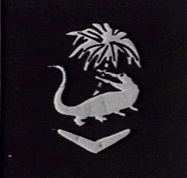
A sapper, also called pioneer or combat engineer, is a combatant or soldier who performs a variety of military engineering duties such as breaching fortifications, demolitions, bridge-building, laying or clearing minefields, preparing field defenses, as well as working on road and airfield construction and repair. They are also trained to serve as infantry personnel in defensive and offensive operations. A sapper's duties are devoted to tasks involving facilitating movement, defence and survival of allied forces and impeding those of enemies. The term "sapper" is used in the British Army and Commonwealth nations, the Polish Army and the U.S. military. The word "sapper" comes from the French word sapeur, itself being derived from the verb saper.

A combat engineer in many armies is a soldier who performs a variety of construction and demolition tasks under combat conditions.

The Royal Australian Armoured Corps (RAAC) is a corps of the Australian Army which provides the Australian Defence Force's armour capability. Armour combines firepower, mobility, protection and networked situational awareness to generate shock action and overmatch in close combat. Armour is an essential element of the combined arms approach that is employed by the Australian Army.
The Corps of Royal New Zealand Engineers is the military engineering regiment/corps of the New Zealand Army. Linton Camp has been known throughout the Army as the traditional home of the Engineers. The role of the Engineers is to assist in maintaining friendly forces' mobility, deny freedom of movement to the enemy, and provide general engineering support.

The Special Operations Engineer Regiment (SOER) is a specialised unit of the Australian Army. The Regiment forms part of the Special Operations Command. The unit was formed in 2002 as the Incident Response Regiment (IRR), they are deployed to respond to chemical, biological, radiological, nuclear or explosive incidents. The Regiment was transferred into the newly raised Special Operations Command in 2003. In 2010 and 2011 its role changed to supporting the army's special forces units, and it was renamed accordingly.

The 4th Armoured Brigade was an armoured formation of the Australian Army established during the Second World War. It was formed in February 1943 to provide armoured support for infantry units operating in the South West Pacific Area. Its composition varied over time, but usually comprised several armoured regiments equipped with Matilda II or M3 Grant tanks as well as some support units.
41 Combat Engineer Regiment is an Army Reserve (militia) unit of the Canadian Military Engineers/Royal Canadian Engineers (RCE) in Alberta, Canada. The unit consists of:

The Arizona Army National Guard is a component of the United States Army and the United States National Guard. National coordination of various state National Guard units are maintained through the National Guard Bureau.
The 22nd Engineer Regiment is an Australian Army engineer unit. It was originally raised as a construction regiment designated "22nd Construction Regiment", but was renamed the "22nd Engineer Regiment" in 2013, following amalgamation with the 4th Combat Engineer Regiment. It consists predominantly of Australian Army Reserve soldiers, that are part-time, and it also has an Australian Regular Army (full-time) component staff. It is based in Victoria, Australia. Part of the 4th Brigade it provides engineer support to the 2nd Division. It is the Senior Engineer Regiment in the 2nd Division, and the second most Senior Engineer Regiment in the Australian Army after the 3rd Combat Engineer Regiment.

The Royal Australian Engineers (RAE) is the Military engineering corps of the Australian Army. The RAE is ranked fourth in seniority of the corps of the Australian Army, behind the Staff Cadets, Armoured and Artillery Corps. The corps was formed by the amalgamation of the various colonial engineer corps of the states and territories of Australia in 1902 and since then has served in various conflicts including World War I, World War II and the Vietnam War. The corps has also served on numerous peacekeeping operations and was heavily involved in the Australian contribution to the war in Afghanistan.

The Corps of Engineers of the Indian Army has a long history dating back to the mid-18th century. The earliest existing subunit of the Corps dates back to 1777 while the Corps officially recognises its birth as 1780 when the senior most group of the Corps, the Madras Sappers were raised.

8th Brigade is an Australian Army Reserve training formation. It is headquartered in Sydney, and has subordinate units in various locations around New South Wales and the rest of Australia. These units are tasked with delivering basic and initial employment training to Reserve soldiers.
The 2nd Combat Engineer Regiment(2 CER) is an Australian Army combat engineer regiment located at Gallipoli Barracks in Brisbane, Queensland. It is part of the Australian 7th Brigade, attached to Forces Command (Australia).
5th Engineer Regiment is a Reserve unit of the Royal Australian Engineers. Originally raised as the "5th Combat Engineer Regiment" in 1995 from the 4th Field Engineer Regiment, it is based in Holsworthy, Sydney, with one of its sub-units based at the multi-user depot HMAS Harman, in Canberra and another at Orchard Hills in western Sydney. Some of the unit's subunits draw lineage from the 4th and 5th Field Companies, which were raised for service during World War I.
The 1st Combat Engineer Regiment is a combat engineer regiment of the Australian Army. Based in the Northern Territory and attached to 1st Brigade, it is a Regular Army unit of the Royal Australian Engineers and is tasked with providing mobility and counter mobility support.
4th Combat Engineer Regiment was an Australian Army Reserve engineer regiment based at East Ringwood, Victoria. Raised on 1 July 1995, upon formation, the regiment consisted of the 10th and 35th Field Squadrons and the 38th Support Squadron. It is an Army Reserve unit that provides engineering support to the 4th Brigade, and played a pivotal role in the ADF support to the 2003 Victorian Alpine Fires and the 2009 Black Saturday Fires. Throughout 2009, the regiment also contributed personnel to operations overseas, including deployments to Afghanistan and the Sinai; other personnel took part were detached to Rifle Company Butterworth and Operation Resolute. In 2013, 4 CER merged with the 22nd Construction Regiment, to form the 22nd Engineer Regiment.

The 8th Paratroopers Engineer Regiment "Folgore" is the Italian Army's airborne combat engineer unit. The regiment provides close combat support to the Paratroopers Brigade "Folgore". The unit is fully professional, able to deploy with on short notice and capable to fight in every environment. In peacetime it is available to support the civil protection, be it for disposing explosive remnants of war or in case of natural disasters.
The 11th Engineer Regiment(11ER) is an Australian Army Reserve engineer regiment trained for sapper/combat engineer and construction engineer operations. While 11 ER was formed on 1 January 2014 as a result of recent Australian Army modernisation efforts, 11 ER's lineage is traced back to early Queensland volunteer engineer units as early as 1879. In 1916, 11th Field Company was formed and during World War I, this unit was renowned for action during the Battle of the Somme and the Hindenburg Line. During World War II, it fought the Japanese during the Kokoda Track campaign and on Bougainville Island. The Regiment's Headquarters is located at Gallipoli Barracks in Brisbane, Queensland with subunits located across Queensland. 11ER is part of 11th Brigade, attached to Forces Command.

The School of Engineers is part of the South African Army Engineer Formation, which provides combat engineering corps training and teaching to military officers and personnel as well as other Military Schools throughout the South African National Defence Force. They are currently the only Military School in Southern Africa to formally present IEDD.
The South Pacific Peacekeeping Force (SPPKF) was an Australian-led peacekeeping force established during the Bougainville Civil War. Hastily established to provide security for peace talks around Arawa, the force consisted of an infantry security force, supported by various logistic and aviation assets, which were deployed and air and sea from Australia. Troops were drawn from Australia, New Zealand, Tonga, Vanuatu and Fiji. The force was deployed between 4 and 21 October 1994 before being withdrawn. Further peacekeeping troops were deployed to the island in 1997 as part of the Truce Monitoring Group.











